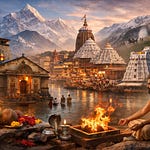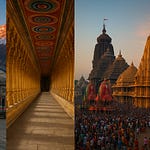The Gorakhnath Temple, located in Gorakhpur, Uttar Pradesh, is not just a prominent religious center but also a spiritual powerhouse rooted in the Nath Sampradaya (sect). Dedicated to Yogi Gorakhnath, a revered saint and yogi, the temple attracts millions of devotees, spiritual seekers, yogis, and pilgrims every year. It serves as the epicenter of the Nath tradition, blending elements of Shaivism, Hatha Yoga, and Tantric spirituality.
🕉️ Foundation & Origin
📖 Legend and Divine Connection
The origins of the temple are closely tied to the life and teachings of Gorakhnath, an 11th-12th century saint who is considered a manifestation of Lord Shiva. Gorakhnath is said to have meditated in the forests of present-day Gorakhpur, spreading the knowledge of yoga and self-realization.
He was the disciple of Matsyendranath, and together they laid the foundation of the Nath Panth, one of the most significant Shaivite yogic traditions.
🧘 The Nath Legacy
Gorakhnath was a master of Hatha Yoga and is credited with composing several important tantric and yogic scriptures. His teachings emphasized:
Self-discipline (Swarajya)
Celibacy (Brahmacharya)
Inner purity and meditation
Direct union with the divine
🛕 Architecture and Temple Layout
The architecture of the Gorakhnath Temple combines traditional Hindu temple design with Nath symbols and cultural motifs. The present structure was built and expanded over centuries, most recently under the patronage of Mahants (head priests) associated with the Nath order.
Architectural Highlights:
Main Sanctum (Garbhagriha): Houses the Samadhi (tomb) and idol of Gorakhnath.
Yagya Mandap: A space for fire rituals and spiritual congregations.
Meditation caves: Underground and secluded spaces where sadhus and yogis practice austerity.
Akhara zones: Residential and training areas for Naga and Nath monks.
Gau Shala: A cowshed symbolizing devotion and simplicity.
The temple exudes an aura of discipline, mysticism, and yogic energy.
📜 Historical Importance
Medieval and Colonial Era
The temple has seen various political and religious upheavals during the Mughal and British eras. Despite invasions and socio-political transitions, the Nath Yogis preserved their cultural identity and continued the spiritual practices of their lineage.
Modern Political Influence
The temple also gained national attention due to its association with Yogi Adityanath, the current Chief Minister of Uttar Pradesh, who is also the present Mahant of the Gorakhnath Math. Under his leadership, the temple complex has undergone restoration and infrastructural enhancements.
🙏 Rituals, Pujas, and Daily Schedule
Daily Puja Timings:
Morning Aarti: 4:30 AM
Midday Bhog Puja: 12:00 PM
Evening Aarti: 7:00 PM
Night Puja & Closing: 9:00 PM
Common Rituals:
Abhishek (ritual bath) of the deity and the Samadhi
Rudrabhishek and special chanting of Shiva mantras
Havan (sacred fire ritual) conducted during auspicious days
Distribution of Prasadam post-aarti to devotees
Special pujas during Makar Sankranti and other Hindu festivals
🧘 Festivals and Major Events
Makar Sankranti Mela: The most significant annual festival where lakhs of devotees gather for spiritual darshan and dip in sacred kunds.
Guru Purnima: Celebrating the guru-shishya tradition, honoring Gorakhnath as the eternal guide.
Maha Shivaratri: Special night-long pujas and chants for Lord Shiva and Gorakhnath.
Navratri and Holi: Celebrated with bhajans, cultural performances, and spiritual lectures.
✨ Spiritual Importance
The spiritual significance of the Gorakhnath Temple lies in its role as:
A seat of yoga and tantra, offering initiation and guidance.
A center for inner transformation, helping seekers detach from materialistic pursuits.
A spiritual university of the Nath Panth, where advanced yogic teachings are transmitted.
A symbol of resistance and preservation of Hindu dharma during turbulent historical periods.
Many devotees report inner peace, energy elevation, and healing after visiting the temple and meditating in its aura.
🧭 Travel Guide: How to Visit
📍 Location:
Gorakhnath Temple, Gorakhpur, Uttar Pradesh, India
🛫 Nearest Airport:
Gorakhpur Airport (GOP): ~8 km away
🚉 Nearest Railway Station:
Gorakhpur Junction: Well-connected via major Indian cities
🏨 Accommodation:
Yatri Niwas and Guest Houses within the temple
Budget and premium hotels available nearby
🕰️ Best Time to Visit:
October to March (pleasant weather)
During Makar Sankranti Mela for a spiritual immersion
🌺 Tips for Devotees and Spiritual Seekers
Maintain silence and observe modesty in the temple.
Photography inside the sanctum is usually restricted.
Participate in the evening aarti for a divine experience.
Visit nearby Gita Press for spiritual literature.
Spend time meditating near the Samadhi Sthal of Gorakhnath.
The Gorakhnath Temple is more than just a religious monument—it's a spiritual legacy, a center of yogic wisdom, and a symbol of cultural resilience. It continues to inspire millions to pursue the path of self-realization, discipline, and devotion. Whether you're a devotee, a yogi, a seeker, or a curious traveler, Gorakhnath Temple offers a deeply transformative experience.










